Bruce Springsteen released the album The Ghost of Tom Joad in 1995. The album was his first album (Billboard highest rank #11) not to reach the Top 10 albums on Billboard 200 after a streak of eight consecutive Top 5 albums.
The highway is alive tonight
But nobody’s kiddin’ nobody about where it goes
I’m sittin’ down here in the campfire light
Searchin’ for the ghost of Tom Joad– Bruce Springsteen “The Ghost of Tom Joad”
Bruce Springsteen’s music career is one that I have followed since 1972 when I was fortunate enough to be in radio distance of a great rock radio station in Norfolk, Virginia that played Greetings from Asbury Park tunes regularly when I was in 6th grade and lived at Fort Eustis, Virginia.
The Ghost of Tom Joad is one of Bruce’s albums I listen to more frequently these days. Here is youTube video of Bruce performing The Ghost of Tom Joad.
The Grapes of Wrath by John Steinbeck
Only a couple of years ago did I finally hear a reference that Tom Joad was the protagonist of John Steinbeck’s The Grapes of Wrath (1939). The novel won the National Book Award and Pulitzer Prize.
Like Sherlock Holmes I have major gaps in my knowledge base. I can talk Dostoevsky and Gogol, but I’m not too familiar with Steinbeck and Faulkner. Consequently, I never read any John Steinbeck before this year and I still haven’t read The Grapes of Wrath. But, like Bruce Springsteen and Woody Guthrie before him, I’ve seen the 1940 John Ford movie.
The basic story is farmers from Oklahoma during the 1930s great depression lose their farm and the dustbowl, a major drought that makes growing crops near impossible in Oklahoma, Texas and Arkansas forces hundreds of thousands of migrants to move to California looking for work and land.
Tom Joad and family come to California and experience life in the migrant camps. There were hundreds of workers applying for every menial job. Wages were low due to the bargaining power being at the growers’ discretion. Fighting for higher wages was truly a fight between company thugs and workers trying to organize and the result in the novel is Tom Joad ends up killing a farmers association anti-union thug who had killed Tom’s friend and Tom has to flee the migrant camp and leave his family.
Steinbeck (1902-1968) grew up in the Salinas Valley and Monterey Peninsula and he was knowledgeable about agricultural farming and working conditions in the fields. He visited migrant camps in California during the 1930s and wrote stories on different types of people living in conditions of poor sanitation, low wages and food scarcity. People were travelin’ hard in California back then.
The Grapes of Wrath tells a story that was representative of the state of life in California for hundreds of thousands of families at the time it was published. The story bears great relevance to many of the conditions in the country today for people struggling to find work, a home and enough food. Travel for survival is a very different condition than travel for leisure or business work.
32nd annual Steinbeck Festival, Salinas, California May 3-6, 2012
Internet searches over the past year reading stuff about John Steinbeck’s work and life left me wanting to know more about this man who made Monterey County and the California Central Valley agricultural fields and orchards a world-famous location through his American literature.
That is why I jumped on the opportunity to get a press pass to the 32nd annual Steinbeck Festival in Salinas May 3-6, 2012.
Photo: Salinas Valley artichoke plants near Castroville I passed driving back to Monterey from Salinas. “No Trespassing” sign in the foreground and Mount Toro in the background.
While I learned much more about John Steinbeck as a man and writer and traveler through the National Steinbeck Center exhibits and a few seminars, the real immersion in new knowledge I experienced last week at the Steinbeck Festival was learning a great deal about American folksinger Woody Guthrie (1912-1967). I am a music fan and I steered myself to most of the Woody Guthrie seminars.
Woody Guthrie and Ramblin’ Jack Elliott, New York City, 1954
Woody Guthrie Centennial 2012
In 1996 the Rock and Roll Hall of Fame and Museum in Cleveland, Ohio and Case Western Reserve University in the same city presented a ten-day celebration honoring Woody Guthrie. This was the first major conference organized around presenting the legacy of Woody Guthrie with photos, lectures, films and concerts held in support of the Woody Guthrie Archives.
Robert Santelli organized that event in 1996. I had never heard of Robert Santelli before last weekend at the 32nd annual Steinbeck Festival in Salinas presented in conjunction with the Woody Guthrie Centennial.
Robert Santelli has written books on Woody Guthrie and Bruce Springsteen. He was Vice President of Education and Public Programs for the Rock and Roll Hall of Fame in Cleveland, Ohio (1993-2000), CEO of the Experience Music Project Museum in Seattle (2000-2008) and is currently the Executive Director of the Grammy Museum in Los Angeles (2008 – present).
A California photographer/journalist I met at the 32nd annual Steinbeck Festival pointed out to me the small group of only about 200 people meant an opportunity to speak directly with people like Robert Santelli during the breaks between seminars and music presentations.
Bob Santelli is one of the driving forces behind the Woody100 centennial events and he gave a dynamic seminar on the legacy of Woody Guthrie last Friday at the Steinbeck Festival in Salinas.
Woody Guthrie also wrote a song “Tom Joad” aka “Ballad of Tom Joad” after seeing the movie The Grapes of Wrath. The story behind the song is Woody sat down at a typewriter one night in New York City with a half-gallon of wine and the next morning the bottle was empty and the song was done. John Steinbeck reportedly said something to the effect that Woody’s 17 verses of Tom Joad could have saved him the trouble of writing a novel.
There was a Steinbeck Festival seminar given by Gavin Cologne-Brookes, American Literature professor at Bath Spa University England, “The Ghost of Tom Joad: Steinbeck, Guthrie and Springsteen”. The seminar was loaded with information about the novel and songs, but he didn’t play any music to enlighten us.
I had never heard Tom Joad by Woody Guthrie and I don’t think the song was played in the three Woody Guthrie musical concerts given over three evenings at the Festival.
Tom Joad – Part 1 and 2 – Woody Guthrie (1940).
“My eyes has been my camera taking pictures of the world and my songs has been my messages that I tried to scatter across the back sides and along the steps of the fire escapes and on the window sills and through the dark halls…” Bound for Glory (1943) – Woody Guthrie autobiography.
Nora Guthrie, Sarah Lee Guthrie and Johnny Irion
The Woody Guthrie Centennial Concert featured Woody Guthrie’s grand-daughter who is musician Arlo Guthrie’s daughter. Arlo is Woody’s son. Sarah Lee performs with her husband Johnny Irion who is the nephew of Thom Steinbeck, John Steinbeck’s son. Although John Steinbeck and Woody Guthrie never met, there is now a Steinbeck-Guthrie familial connection.
Sarah Lee and Johnny did a wonderful rendition of “California Stars”, lyrics of Woody Guthrie with music by Jeff Tweedy and Jay Bennett of Wilco you can hear here in this YouTube video performed by Billy Bragg and Wilco.
Nora Guthrie, Woody Guthrie’s daughter, Arlo Guthrie’s sister and director of the Woody Guthrie Foundation, joins Sarah Lee and Johnny on stage to sing “This Land is Your Land”. Rob Wasserman, bassist extraordinaire, accompanied Sarah Lee and Johnny. Nora Guthrie had a great story to tell about meeting Bob Dylan the first time.
Blogger Disclosure: The basic deal is I got a 3-day press pass to the Steinbeck Festival that allowed me to get a really fantastic experience with hours of lectures, music, film, activities and a chance to meet knowledgeable people. The festival at times seemed like a social activism progressives’ workshop for change in America. #Occupy repeatedly came up as a bright sign in current social awareness. There was top-notch talkin’ and singin’ going on for three days and my experiences would cost regular paying folk about $200 in ticket fees.
Learning a bit of American music, literature and historical culture is the kind of travel experiences I enjoy. I will likely write a couple more posts on the 2012 Steinbeck Festival May 3-6 at the National Steinbeck Center Salinas, California.
That is my payment for free passage to the Steinbeck Festival.
National Steinbeck Center Salinas, California is open year round.
Woody100.com shares the calendar for other Woody Guthrie events happening in 2012.
WoodyGuthrie.org has a thorough listing of about 3,000 Woody Guthrie song lyrics, biography and other educational links.


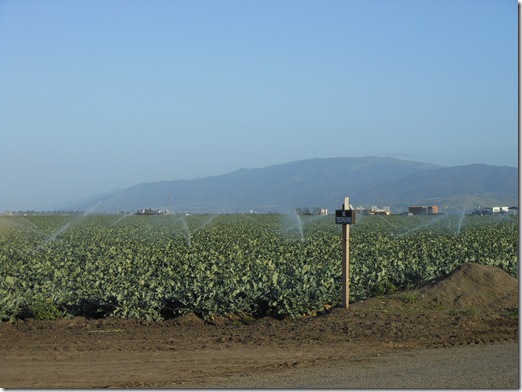
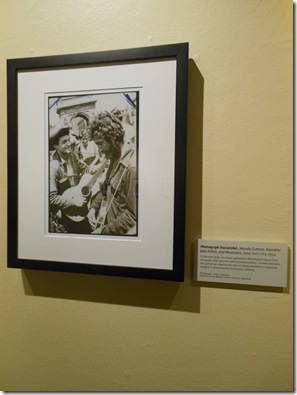
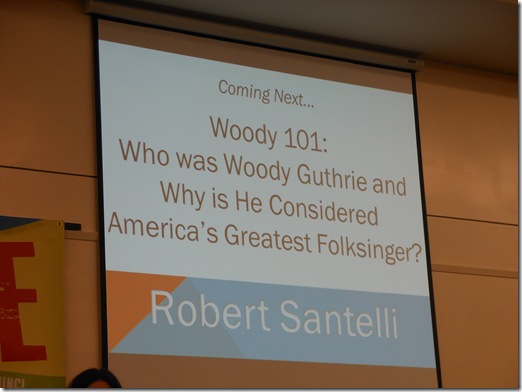
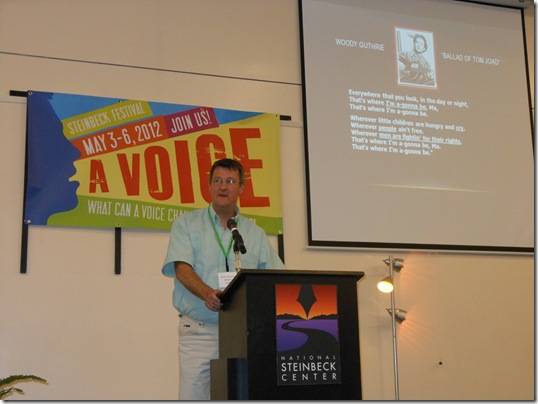
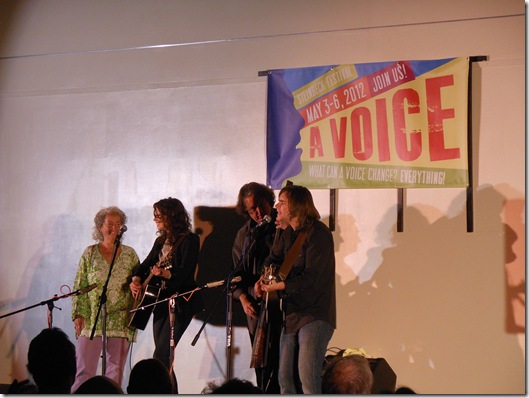
10 Comments
Comments are closed.